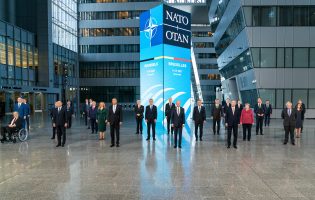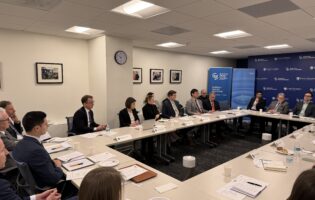Education, Organization, and Technology: The Keys to Muslim Integration in the U.S. and Germany
On January 27, 2012, the American-German Institute (AGI), together with the Islamic Society of North America (ISNA), hosted a workshop on “Education, Organization, and Technology: The Keys to Muslim Integration in the U.S. and Germany.” The workshop was generously supported by the Draeger Foundation.
Bringing together an interdisciplinary group of young scholars, practitioners, and experts from Germany and the United States, this workshop discussed Muslim integration and immigration in both countries. The group of discussants analyzed Islamic education, the role of Imams, Muslim organizations and questions of representation and leadership, and the relevance of technology in integration. A core group of young leaders shared their experiences and insights, followed by conversation among the participants and audience.
The first panel looked at the role and education of Imams, and the challenges associated with the “importation” of Imams. Participants discussed the differences in the U.S. and Germany, including both policies and communities. Muslim communities in the U.S. are trying to carve out uniquely American Islamic experiences. Imams are employees or volunteers in their communities, and reflect the values and aspirations of their community. Imported Imams do not understand the changes underway in the U.S., especially among the second generation of American Muslims. The role of the Imam depends on how the Imam views the mosque—as an outpost of the “old country,” or as a forward-looking opportunity to encourage Islam for future generations. Imams in the U.S. have an expansive role in the community, beyond leading prayers, for which they are not fully prepared. By creating a cadre of Islamic scholars who are also aware of American culture and experience, Imams can better understand that Islam is a part of the U.S.
Understanding the role of the Imam is also a challenge in Germany. Many Imams are unprepared for life in Germany—they do not speak German, and do not understand politics, culture, or society. When mosques were founded in Germany, they were an attempt to create part of the old country in Germany, and Imams were imported from other countries. The diverse group of Muslims in Germany, and the growing notion of Germany as a country of immigration, means that the discussion on the role of Islam in German society is gaining traction. The German Islam Conference (DIK) provides a platform for this discussion and seeks to develop a guidebook for Imams that shows the relationship between society and religion. Education of Imams—both theological and practical—is growing in Germany.
The topic of education was continued in the next panel, when discussants turned to the topic of Islamic education in public schools. The group analyzed Islamic education in public schools, which continues to be a somewhat controversial issue in Germany. Even though small pilot projects have started to offer Islamic religious education in some public schools, no large-scale introduction of the subject is currently planned. The fractured state of responsibilities for school education among the German states adds an additional problem.
Panel Three analyzed Muslim organizations, representation, and leadership. In Germany, Muslim organizations are fragmented due to the nature of Islam (and the idea of a direct connection to God), the German community of guestworkers, and German migration policy. The Central Council for Muslims acts as a lobbyist group, and provides services for Muslims. However, other existing organizations in Germany continue to work in their traditional patterns, are influenced by the “old country,” and are not transparent about their membership. Organizations for the most part are not connecting people with new, fresh ideas.
The American Muslim community is diverse, with a number of organizations that cater to different groups. Many Muslims prefer to not have an overarching organization or spokesperson. Different organizations are able to mobilize around certain causes, such as disaster relief, and will cooperate in order to pool their various memberships together and have a stronger voice. In terms of integration, however, Muslim organizations are not especially effective; rather, it is better to promote being a good Muslim-American in a non-Muslim setting to achieve integration.
In both the U.S. and Germany, there is no political integration on the national level, and a lower level of political integration at the regional level, with little Muslim presence in civil society organizations. More young leaders and an emphasis on culture, arts, and sports can help integration at the regional or local level. However, top-level challenges to integration remain, especially in Germany. These include: building a German identity within German society; connecting prayers or sermons to daily life, rather than to the “old” country; understanding German history and society.
The final panel looked at the relevance of technology to integration. Young Muslims, like their generational peers, use social media such as Facebook, Twitter, etc. The pulpit is no longer at the mosque but on the web and e-Imams take the place of Imams at the mosque. Even though modern technology continues to make contact between humans easier, 63 percent of Muslims say that they do not know any Muslim personally and most Americans receive information on Muslims through the media. Through modern technology, local issues are elevated to national or even international issues in an instant. Sometimes this has negative consequences (e.g., the Ground Zero mosque) or positive effects (during the Arab Spring). It is important to understand the new technology and the media have become an important tool, especially for young Muslims; the messages that are being spread by these technologies thus matter even more. Technology can be used to spread hatred or to remove barriers between Muslims and non-Muslims. Muslims in Germany and the U.S. currently already use technology to connect across nations, and have spirited debates about issues of religion, secularity, and relations between Muslims and non-Muslims. However, the question how to broaden this discussion to non-Muslims is not yet solved. Muslim organizations need to develop content and also technologically-savvy communication strategies to reach Muslims and non-Muslims alike.







